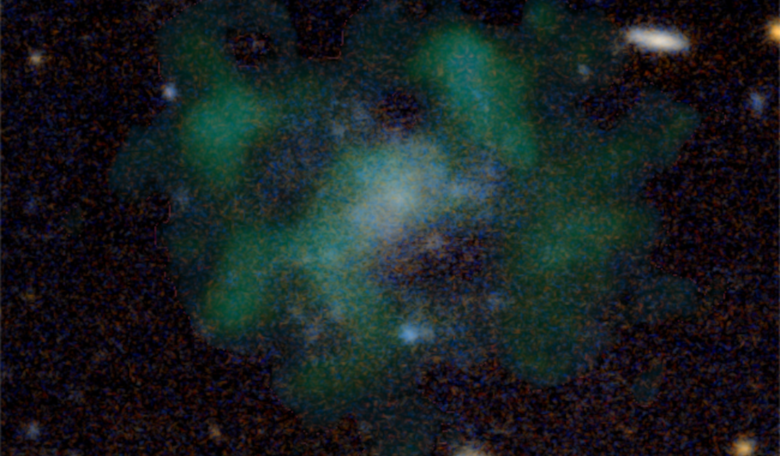Thought to make up about 27 percent of the matter in the Universe and be the reason why galaxies and galaxy clusters do not fly apart, dark matter is key to our understanding of many cosmological phenomena. But now a new study by an international team of astronomers could be about to turn the situation on its head, as a 40 hour examination with state-of-the-art telescopes of AGC 114905, an ultra-diffuse dwarf galaxy about 250 million light-years away, has turned up with no trace of this mysterious material.
The idea of dark matter became a more popular notion in the 1930s, when after measuring the amount of visible mass in the Coma Cluster, and comparing it to the motion of the galaxies, Swiss astronomer Fritz Zwicky found that the individual galaxies were moving too fast for the cluster to remain bound together. Something unseen appeared to be keeping the galaxies together, but what?
Zwicky hypothesised that an as-yet unobserved type of mass, dunkle Materie (dark matter) that lay hidden in enormous quantities might have enough gravity to keep the rapidly moving galaxies from flying apart. The theory was initially met with much skepticism, but many years later his observations of “missing mass” were confirmed by other groups of astronomers.
Since then, the idea of dark matter has become widely accepted and various candidates have been proposed to account for what it might be, such as so-called weakly interacting massive particles (‘WIMPs’), gravitinos or axions – hypothetical ultralight particles used to describe the behavior of subatomic particles.
However, in the past couple of years, astronomers are starting to find galaxies that buck the trend. In 2018, Pieter van Dokkum at Yale University, USA, and colleagues found an ultra-diffuse galaxy known as NGC1052-DF2 with hardly any dark matter, suggesting instead that this elusive material is “a distinct “substance” and “separable from galaxies”.
A year later, Pavel Mancera Piña at the University of Groningen, Netherlands, and colleagues discovered six galaxies with little to no dark matter, one of which was AGC 114905.
Advised to “measure again”, to find the dark matter around the galaxy, Piña and colleagues did just that.
Using the VLA telescope instead of the Karl G. Jansky Very Large Array that was used in the initial study, the team collected data on the rotation of gas in AGC 114905 for 40 hours between July and October 2020.
AGC 114905 is about the size of our own Milky Way but contains a thousand times fewer stars. Because of this characteristic AGC 114905 is classified as an ultra-diffuse dwarf galaxy, with the name “dwarf galaxy” referring to its luminosity and not to its size.
When visualised on a graph showing the distance of the gas from the centre of the galaxy on the x-axis and the rotation speed of the gas on the y-axis – a standard way to reveal the presence of dark matter – the team’s data shows that the motions of the gas in AGC 114905 can be completely explained by just normal matter.
"This is, of course, what we thought and hoped for because it confirms our previous measurements," says Pavel Mancera Piña. "But now the problem remains that the theory predicts that there must be dark matter in AGC 114905, but our observations say there isn't. In fact, the difference between theory and observation is only getting bigger."
Why this galaxy would have no dark matter when it is expected to do so, the team do not yet know. They have ruled out AGC 114905 being stripped of dark matter by large nearby galaxies because there aren’t any, and have also discounted the so-called cold dark matter model, as it would mean the introduction “of extreme parameter values that are far beyond the usual range,” say Piña and colleagues.
The team also report that an alternative theory to dark matter, known as MOND (MOdified Newtonian Dynamics, a hypothesis that proposes a modification of Newton's law of universal gravitation to account for observed properties of galaxies) doesn’t fit the data either.
There is one more assumption that could change their conclusions, say the team and that is the estimated angle at which they think they are observing the galaxy. "But that angle has to deviate very much from our estimate before there is room for dark matter again," says co-author Tom Oosterloo at ASTRON, Netherlands Institute for Radio Astronomy.
The team are now examining a second ultra-diffuse dwarf galaxy in detail to see if it too lacks dark matter. If it does, it will make the case for dark matter poor galaxies even stronger, say Piña and colleagues
The team’s research, “No need for dark matter: resolved kinematics of the ultra-diffuse galaxy AGC 114905,” will be published in the journal Monthly Notices of the Royal Astronomical Society.











